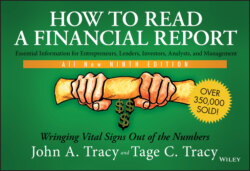Читать книгу How to Read a Financial Report - John A. Tracy - Страница 7
1 STARTING WITH CASH FLOWS Summary of Cash Flows for a Business
ОглавлениеSavvy business managers, lenders, and investors pay a lot of attention to cash flows. Cash inflows and outflows are the pulse of every business. Without a steady heartbeat of cash flows, a business would soon have to go on life support—or die. So, we start with cash flows.
Cash inflows and outflows appear in a summary of cash flows. For our example in Exhibit 1.1, we use a business that has been operating for many years. This established business makes profit regularly and, equally important, it keeps in good financial condition. It has a good credit history and banks lend money to the business on competitive terms. Its present stockholders would be willing to invest additional capital in the business, if needed. None of this comes easy. It takes good management to make profit consistently, to secure capital, and to stay out of financial trouble. Many businesses fail these imperatives, especially when the going gets tough.
EXHIBIT 1.1 SUMMARY OF CASH FLOWS DURING YEAR
| Dollar Amounts in Thousands | |
| Cash Flows of Profit-Making Activities | |
| From sales of products to customers, which includes some sales made last year | $(51,680) |
| For acquiring products that were sold, or are still being held for future sale | $(34,760) |
| For operating expenses, some of which were incurred last year | $(11,630) |
| For interest on short-term and long-term debt, some of which applies to last year | $11,(520) |
| For income tax, some of which was paid on last year’s taxable income | $3(1,665) |
| Net cash flow from profit-making activities during year | $113,105) |
| Other Sources and Uses of Cash | |
| From increasing amount borrowed on interest-bearing notes payable | $(11,625) |
| From issuing additional capital stock (ownership shares) in the business | $(((2175) |
| For building improvements, new machines, new equipment, and intangible assets | $ (3,625) |
| For distributions to stockholders from profit | $11 (750) |
| Net cash decrease from other sources and uses | $)(3,575) |
| Net cash increase (decrease) during year | $11 (470) |
Exhibit 1.1 summarizes the company’s cash inflows and outflows for the year just ended, and shows two separate groups of cash flows. First are the cash flows of its profit-making activities—cash inflows from sales and cash outflows for expenses. Second are the other cash inflows and outflows of the business—raising capital, investing capital in assets, and distributing some of its profit to shareowners.
We assume you’re fairly familiar with the cash inflows and outflows listed in Exhibit 1.1. Therefore, we are brief in describing the cash flows at this early point in the book:
The business received $51,680,000 during the year from selling products to its customers. It should be no surprise that this is its largest source of cash inflow. Cash inflow from sales revenue is needed for paying expenses. During the year the company paid $34,760,000 for the products it sells to customers. And, it had sizable cash outflows for operating expenses, interest on its debt (borrowed money), and income tax. The net result of its cash flows of profit-making activities is a $3,105,000 cash increase for the year—an extremely important number that managers, lenders, and investors watch closely.
Moving on to the second group of cash flows during the year, the business increased the amount borrowed on notes payable by $625,000 and its stockholders invested an additional $175,000 in the business. Together these two external sources of capital provided $800,000, which is in addition to the internal $3,105,000 cash from its profit-making activities during the year. On the other side of the ledger, the business spent $3,625,000 for building improvements, new machines and equipment, and intangible assets. Finally, the business distributed to its stockholders $750,000 cash from profit. This distribution from profit is included in the second group of cash flows, indicating that the $3,105,000 cash flow from profit is the net cash flow before the distribution to stockholders.
The net result of all cash inflows and outflows is a $470,000 cash decrease during the year. When you see a decrease, don’t jump to any conclusions. In and of itself, the net decrease in cash is neither good nor bad. You need more information than appears on the summary of cash flows to come to any conclusions about the financial performance and situation of the business.
